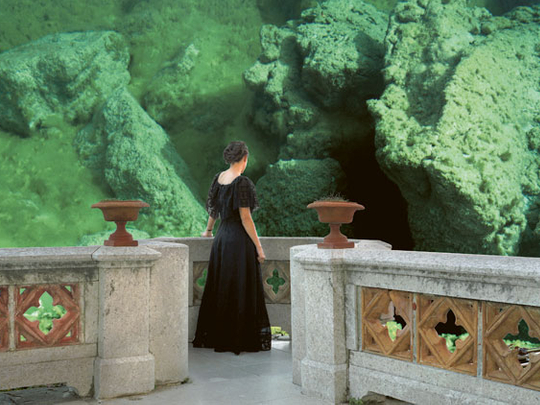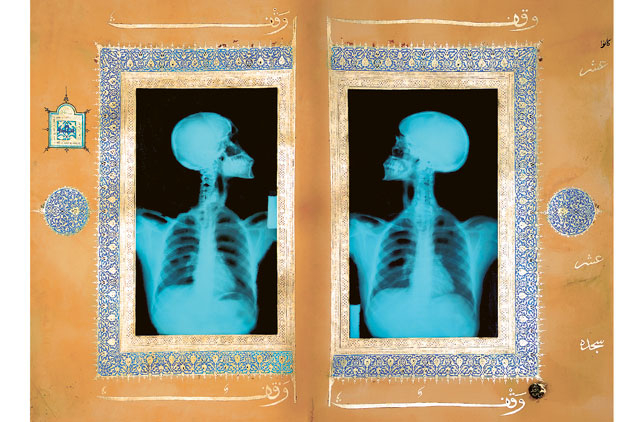
It is time for the sixth Contemporary Istanbul art fair. And it is bigger than last year — extending from the Istanbul Convention and Exhibition Centre to the next-door Istanbul Congress Centre — and showcasing 3,000 contemporary artworks created by 550 national and international artists. The event highlights the position of art and culture in the Turkish capital and approaches the heterogeneous tastes of its multicultural audience. Artists and art lovers have responded by converging on the city for four days to immerse themselves in contemporary paintings, sculptures, videos, photographs, installations and limited editions. At presstime, more than 1,000 collectors had confirmed their attendance.
Among the participants are 89 contemporary art galleries from 20 countries, including the hosts, with their exhibitions, art initiatives, independent projects and publications along with art institutions. Contemporary Istanbul, which aims to be among the Top 10 art fairs of the world in the next three years, is for the first time hosting galleries from Dubai, such as Etemad Gallery, XVA Gallery and Empty Quarter Gallery, in its New Horizons section, along with the FA Gallery from Kuwait and EOA Projects from Saudi Arabia. Each artwork at the fair has a unique visual language and transports viewers from the land of reality to the fanciful kingdom of art. Some of the artworks can be effortlessly interpreted and provide the audience an instant feeling of connection. Others, however, remain distinctly abstract, and yet engaging.
Weekend Review spoke to two Turkish artists participating in the fair. Azade Köker has travelled the globe and already showcased her art in the US, Japan and Europe.
"Art is a visual, philosophical phenomenon," she said. "It varies, depending on the environment in which it is produced. The status, neighbourhood, political conditions and anthropological view all make a difference. Classifications — such as in law, where there is criminal law or labour law — are not valid for artists today. Therefore, even biographers of the artists struggle to explain their art. No one can really summarise it in a single sentence."
Text plays an important role
Köker, a graduate of the Istanbul Academy of Fine Arts, studied "design" and "sculpture" in the Hochschule für Bildende Künste Berlin. She uses a range of techniques, including collage and photography, paper and cement (in sculptures), and video installations. Text plays a key role in her works. "Indeed, in my works, text assumes the role of a building block for creating the painting, while at the same time lending another dimension to it," she said.
For painter Güçlü Öztekin, 33 — a graduate of Mimar Sinan Fine Arts University — the power of art is an end in itself. "Sure, I don't have a particular philosophy about art. But I believe in how powerful it is," he said. He uses wall acrylic paint, pencils and, sometimes, spray paint. What really matters to Öztekin is the art of orchestration, not the state of depiction. "The most important thing is how the work is orchestrated and what kind of a model it proposes. This is valid for any works but art is more speculative."
What does Köker's artwork revolve around? "It is possible to suggest that the works have been produced with three memories: inner memory, outer memory and third memory," she said. "If the inner memory is established by the records in our mind, we could say that the outer memory is the specification of these records — the particular environments where they nest. There is also the third memory. This is a memory belonging to another space and time. In this project, a meeting of memories takes place at the centre of the work. The confrontation of memories of ancient civilisations in the time and space of today [now] and the expression resulting from these platforms of merging could be mentioned. In other words, a new artistic coordination is created in a three-dimensional space by specifying historical figures there."
Öztekin, who recently held a solo exhibition in Rampa, delves into the origins of art. "There's no such thing as a source of inspiration," he said, adding that art reflects the state of mind. "A work is a summation of different states, and some of them are closer to happiness and are more exciting. But if we listen to [French novelist, critic and essayist Marcel] Proust, the most important works are the result of depression. This doesn't refer to the tragedies of life but stems from a sense of fear about whether the work you're creating will be good enough." It is not surprising, then, that Dutch painter Vincent van Gogh's works have left an indelible impression on Öztekin. So has Peter Paul Rubens, the Flemish painter, he says.
A place for everything
Whom does Köker admire? "Definitely, there are artists that I feel I am close to. But each work of art is worth an analysis. There is secret information in all of them which is difficult for people without art education to comprehend and which is not necessary for them. Occupying ourselves with such things and arguing about them amazes us — we are artists," Köker says.
She said that the Renaissance marked the beginning of significance in historical, social and political dimensions in art, and the Romantic era its end.
"The Renaissance era of art, for the first time, studied the individual alone and as a creative being, and the Romantic period, in which the West transitioned from a feudal system to bourgeoisie, dealing for the first time with the search of social and political identity of the individual.
"It is thought that there are parallels between the social, political and the artistic transformation of these two historical periods and the obscurity of our age and the expectation for a new classification.
"Therefore, here, in the project titled Pose!, I was concerned with the figures of Lucas Cranach [1472-1553], the German Renaissance painter of the North, and Caspar David Friedrich [1774-1840], the Romantic era painter from the North. I arranged platforms for meeting them in the spaces we are in now."
Asked about her assessment of the art movement in Turkey today, she said: "The direction of art in Turkey looks very promising; there is much potential among the young in many fields. My preference would be to support and highlight young artists. Here, I would like to mention that education and initiation to professionalism are at the core of success and continuity." Looking to the future, she is not certain yet about her upcoming projects but she said she could focus more on sculpture.
Öztekin, who is a member of a group called "Hazavuzu", where they practise different art forms, such as music, video and performance, and design, believed "the profession should be continuously well fed by amateur strategies for the continuity of the works".
Along these lines, it is the new "risk-takers" who have lit up his country's art scene, he says.
"The art movement in Turkey now is more interesting, as the market and framework are developing along with the institutions. Even the leaders of the market have either weak technical infrastructure or weak output. The more interesting streams are those new-age formations that take risks, have strategies which are compatible with the market and create works despite the environment."
A medium that binds the world
Internationally, has art bridged the distance between cultures? What did Köker find in her travels? "Well, if people living in different cultures are hiding in their own cultures, art cannot possibly bind them. And people open to the world do not necessarily need art to view other cultures with tolerance. I am on the side of world culture. Regional or national cultures do not excite me," she said.
Through her art, she prefers focusing on a new way of informing, rather than delivering a message.
Fatma Salem is an Emirati writer based in Dubai.
Contemporary Istanbul is being held until November 27 at the Istanbul Congress Centre and the Istanbul Convention and Exhibition Centre in Rumeli Hall.
Contemporary Istanbul 2011, bigger and better
Celebrating its sixth anniversary this year, Contemporary Istanbul 2011 brings together 90 contemporary art galleries from 20 countries, half of these international, featuring art initiatives, independent projects and publications, along with art institutions and exhibitions. About 3,000 contemporary artworks belonging to 526 local and international artists are on display.
The art fair that aims to find a place in the Top 10 list of world art fairs in the next couple of years is dedicated to the development of contemporary Turkish art, introducing the genre to collectors attending the event with pieces that are recognised globally.
"We hope Contemporary Istanbul provides visitors the opportunity to catch up with the latest trends in contemporary Turkish art and that on the global art scene, while at the same time ensuring that it remains the medians through which the international art communities interact," said Ali Güreli, chairman of Contemporary Istanbul.
Ok, hit, hit but don't run
Dubai's Green Art Gallery is participating in the 2011 Contemporary Istanbul Art fair with a solo booth for New York-based artist Shadi Habib Allah. Through the examination of our relationships to systems of infrastructure, class identification and hierarchies of authority, Habib Allah reworks existing structures or makes images of images in ways that eventually erase or replace the original, until it is unclear what is original and what is the copy.
To be shown at the Contemporary Istanbul Art fair is "Ok, hit, hit but don't run", an animation and multichannel video which was first shown at the Palestine c/o during the Venice Biennial in 2009. In this video piece Habib Allah has produced a work whose first point of departure is the elimination of popular Palestinian symbolism. Rather, he produced an animation where he made hundreds of drawings of hominoid figures and, as in his earlier work, gave these figures or "mechanical forms" human attributes.
Despite enacting the cycle of life, procreation, birth, and death however, the figures depicted in the works are stripped of any emotive or symbolic references.












